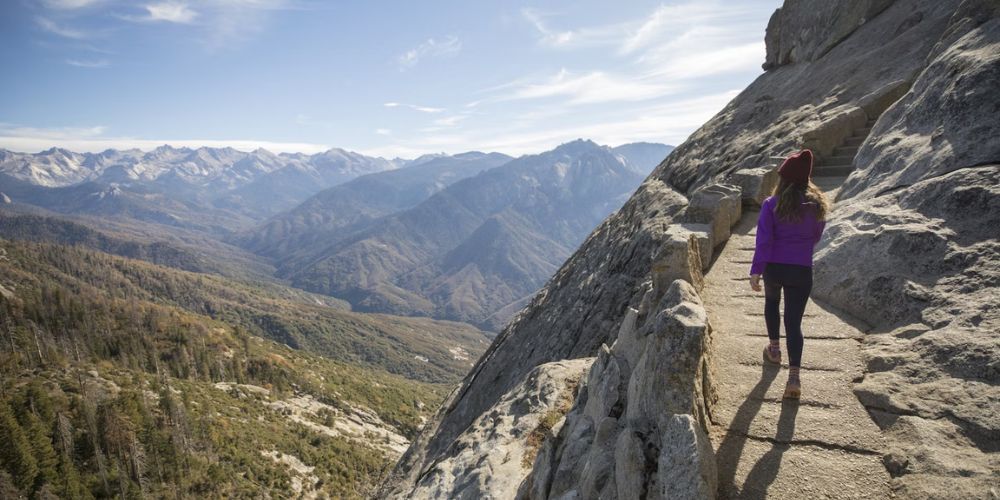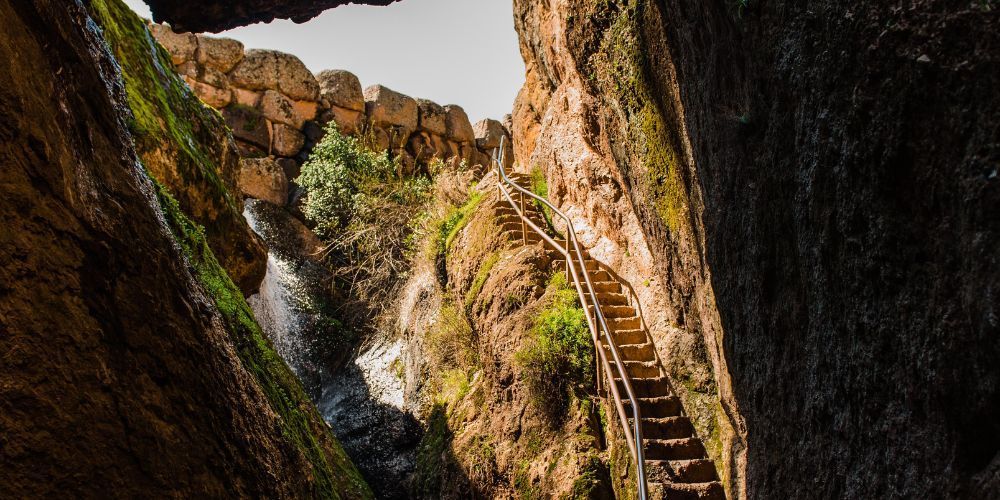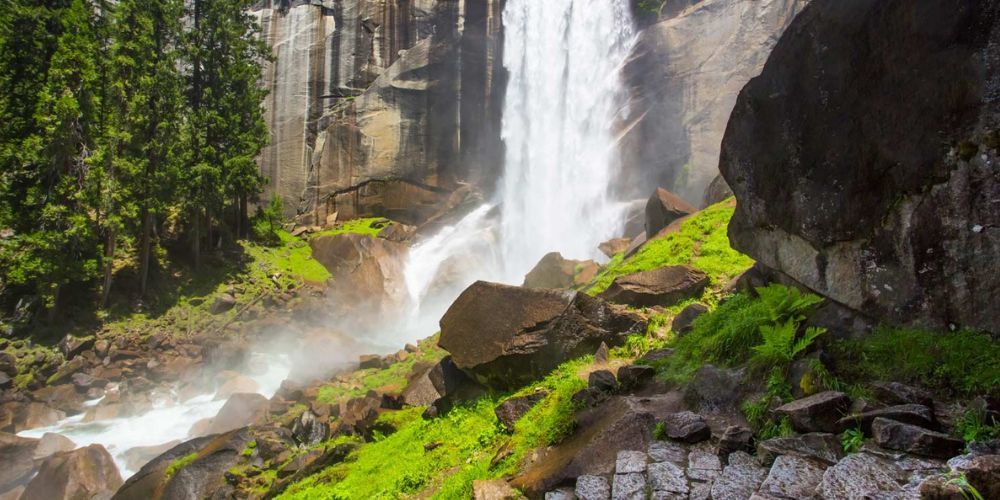Hiking in California: Explore the Best Trails and National Parks
California is a hiker's paradise, brimming with trails that traverse towering granite cliffs, lush forests of giant sequoias, and scenic coastal paths. For those seeking an adventure that balances challenge and beauty, California offers some of the most enchanting hiking experiences. Imagine standing atop Glacier Point in Yosemite National Park, where every step taken rewards you with breathtaking vistas of waterfalls cascading down sheer cliffs—it's moments like these that make every mile worthwhile.
To cater to your enthusiasm and ensure you find the perfect trail suited to your skill level, we've meticulously researched and compiled detailed guides. From traversing desert landscapes on the Pacific Crest Trail to exploring secluded coves along Big Sur's rugged coastline, each trail promises unique encounters with nature. With accurate maps, safety tips, and first-hand insights interwoven throughout this guide, you're equipped not just for any hike but for an unforgettable journey across California’s finest paths.
Some of the best hiking trails in California include Half Dome in Yosemite National Park, the Pacific Crest Trail, and the Mist Trail in Sequoia National Park. These iconic trails offer stunning scenery and a variety of difficulty levels for hikers of all experience levels.

The Best Hiking Trails in California
If you're an avid hiker or outdoor enthusiast seeking an adventure, California is a treasure trove of breathtaking hiking trails. Let's start with one of the most iconic hiking destinations in the world: Yosemite National Park.
Yosemite National Park Trails
Yosemite National Park, a UNESCO World Heritage site nestled in the Sierra Nevada mountains, hosts some of the most picturesque and exhilarating trails in California. Whether you're seeking a challenging ascent or a serene stroll, Yosemite has it all. The Mist Trail to Vernal and Nevada Falls offers a refreshing experience with its cascading waterfalls and lush greenery. For the more daring hikers, the Half Dome Trail provides an adrenaline-pumping adventure with its vertiginous cliffs and unparalleled panoramas.
The park's trails showcase nature at its finest, featuring awe-inspiring waterfalls, towering granite cliffs, and ancient sequoia trees. Exploring these trails is not just an escape into nature but a journey through time, as you witness the immense power and beauty sculpted over millions of years.
Guided by experienced rangers, I personally trekked many of Yosemite's trails and was left in absolute awe by the sheer magnificence of its natural wonders. The feeling of standing before Vernal Fall, its mist kissing my face, left an indelible imprint on my memory. Yosemite truly offers an unparalleled hiking experience that captures both the heart and imagination.
Pacific Crest Trail (PCT)
Spanning 2,650 scenic miles from Mexico to Canada, the Pacific Crest Trail is a mecca for long-distance hikers and nature enthusiasts alike. Running through California's diverse landscapes, this trail showcases the state's rich tapestry of environments—ranging from arid deserts to breathtaking alpine scenes. The PCT provides a once-in-a-lifetime opportunity to immerse yourself in nature's grandeur and navigate through varied ecosystems while forging lasting connections with fellow hikers.
Having had the privilege of trekking portions of the Pacific Crest Trail, I can attest to the life-altering experience it offers. The golden glow of sunrise over desert landscapes gave way to the tranquility of alpine meadows lined with vibrant wildflowers—a journey that transcended physical exertion and evolved into a spiritual communion with nature.
Big Sur Trails
Nestled along California's ruggedly beautiful coastline, Big Sur presents hikers with enchanting trails that afford breathtaking views of the Pacific Ocean. From the ethereal allure of McWay Falls Trail to the rugged charm of Partington Cove Trail, Big Sur boasts hiking experiences that seamlessly blend serenity and scenic grandeur.
While treading these captivating paths myself, I found solace in Big Sur's untouched wilderness. Staring out at infinite horizons across rugged cliffs instilled within me an ever-deepening appreciation for our planet's raw beauty — a reminder of how fortunate we are to share our existence with such wonders.
As we've ventured through these magnificent trails together, it's evident that each has a story to tell—a tale woven by nature's own hand. These experiences reinforce why California remains an enduring destination for hikers seeking immersive encounters with the natural world.
Exploring Mountain and Coastal Paths
When it comes to hiking in California, the contrasting landscapes of the Sierra Nevada Mountains and the picturesque Coastal Trails create a truly magical experience. Each offers a unique experience, beckoning adventurers to explore their natural wonders. Whether you're drawn to the impressive elevation of the Sierras or the rugged beauty of the coastline, there's a path waiting to captivate your senses.
Sierra Nevada Mountains: John Muir Trail
The John Muir Trail is a hiker's dream, offering a breathtaking high-altitude journey through nature's finest work. With elevations surpassing 14,000 feet, this trail winds its way through both Sequoia and Kings Canyon National Parks. The grandeur of this trail is unparalleled as it weaves through pristine alpine lakes, lush meadows speckled with wildflowers, and awe-inspiring granite peaks. Hikers are treated to jaw-dropping vistas at every turn, feeling dwarfed by towering mountains while being humbled by the vast wilderness. The trail spans roughly 211 miles and is an immersive experience that allows you to connect with nature on an unparalleled level.
Coastal Paths: California Coastal Trail
If you find yourself drawn to the allure of the Pacific Ocean, then the California Coastal Trail is where your heart will feel at home. Stretching over 1,200 miles along the stunning Pacific coastline, this trail offers diverse terrains and enchanting views that endlessly inspire.
One of the highlights along the California Coastal Trail is the Lost Coast Trail—a secluded stretch of rugged shoreline known for its untamed beauty. Here, hikers can trade bustling city life for solitude amidst towering cliffs and pristine sandy beaches. This remote paradise promises breathtaking sunsets and serene moments that connect you with nature like never before.
Another gem along the coastal paths is the Point Reyes National Seashore, a coastal haven celebrated for its dramatic cliffs jutting into the ocean and rich marine life habitats. From spotting whales breaching in the distance to capturing mesmerizing sunsets on coastal bluffs, this trail provides an immersive experience that reverberates with natural wonder.
With the magnificent Sierra Nevada Mountains offering unparalleled high-altitude thrills and the captivating Coastal Trails delivering a unique blend of seaside serenity, California truly offers an incredible variety for hikers seeking new adventures.
As we've adventured through California's diverse landscapes, from towering mountains to serene coastlines, let's now turn our attention to conquering some of the tallest peaks in these majestic ranges.
Tallest Peaks to Conquer
California boasts some of the most magnificent peaks in the United States. Mount Whitney, towering at 14,505 feet, commands reverence as the highest summit in the contiguous United States. The hike along the Mount Whitney Trail is undeniably strenuous, covering a grueling 22-mile round trip. But with proper preparation and equipment, it's a feat that many avid hikers aspire to conquer.
Utterly majestic in its own right, Mount Shasta stands at 14,179 feet. It presents an array of routes for climbers, the most popular being the Avalanche Gulch trail which leads to summit attempts. This prominent peak offers a challenge that enchants climbers and provides a different kind of satisfaction from coastal or low-lying trails.
For Southern California enthusiasts, conquering San Gorgonio Mountain proves to be an expedition like no other. Rising to 11,503 feet, this is the highest peak in Southern California. Accessible via a challenging 18-mile round trip trail from Vivian Creek, this hike offers a demanding yet rewarding experience for those seeking an adventure away from the coast.
Imagine standing atop one of these peaks, gazing at awe-inspiring vistas stretching far and wide. The sense of accomplishment one feels after completing such arduous ascents is unmatched. The quiet solitude, the sound of the wind caressing the rocks, and the breathtaking views make every step worth it.
Scaling these heights requires a different level of preparation compared to coastal hikes. It's crucial to acclimatize oneself to avoid altitude sickness. Understanding the risks associated with high-altitude hiking is essential for ensuring a safe and memorable experience.
Navigating these peaks is like solving a puzzle; it requires patience, strategy, and an understanding of your surroundings. Each step presents a new challenge and requires careful consideration—a test of both physical endurance and mental fortitude.
Hiking these monumental peaks calls for meticulous planning and utmost respect for nature's power. Let's now dive into how to prepare for such extraordinary expeditions to ensure a safe and fulfilling climb.
Tips for Diverse Terrains
Hiking trails in California offer a diverse range of terrains and landscapes, each presenting its own set of challenges and requirements. Whether you’re heading out on an arid desert hike, through dense forest trails, or across alpine terrain, it’s crucial to prepare properly so that you can fully enjoy and safely navigate these areas.
Desert Hiking
When trekking through desert landscapes like Joshua Tree National Park or Death Valley, hydration and protection from the sun are paramount. The intense heat can be unforgiving, making it essential to carry ample water and high-SPF sunscreen. Starting early in the day is advisable, helping to mitigate exposure to the scorching midday heat, and providing hikers with more favorable conditions for their excursion. Additionally, clothing that covers your skin combined with a wide-brimmed hat acts as a shield from the sun. Looping these recommendations into one rule: dress in light, breathable layers that provide ample coverage while still allowing air circulation.
Remember: Balance out the weight in your backpack with extra water—hydration is key in these dry environments.
Forest Trails
Trails skirting through lush forest regions such as Redwood National and State Parks offer a vastly different hiking experience. Besides the enchanting scenery, hikers need to look out for obstacles like roots snaking across paths. For this reason, appropriate footwear becomes a critical consideration—sturdy hiking boots with ankle support are invaluable when navigating uneven forest floors. Similarly, insect repellent should not be overlooked. As beautiful as these forests are, they are also home to mosquitoes and ticks; repelling them will make your journey considerably more enjoyable and protect you from potential bites or disease transmission.
Alpine Terrain
Lastly, when preparing for hikes in alpine environments such as those found in the Eastern Sierra Nevada around Mammoth Lakes, one must be ready for rapid weather changes. Carrying adequate gear for altitude sickness prevention and temperature fluctuations is crucial amidst these challenging settings. Additionally, taking frequent breaks ensures proper acclimatization to higher elevations while allowing you to appreciate the breathtaking views these terrains have to offer.
With these tips in mind, you are well-equipped to tackle varied terrains across California's hiking trails. Each environment presents its own unique set of nuances, but following these guidelines allows you to fully immerse yourself in nature while staying safe and prepared along the way.
Armed with knowledge about how to navigate diverse terrains on California's hiking trails, let's now venture into the expansive wilderness of state and national parks.

State and National Parks Wilderness
California is home to an astounding 280 state parks, each offering its own unique blend of natural beauty and outdoor adventure. Whether you're seeking coastal cliffs, ancient forests, or breathtaking waterfalls, the diverse landscape of these parks has something for everyone. When it comes to state parks, two remarkable destinations stand out: Pfeiffer Big Sur State Park and Julia Pfeiffer Burns State Park. These parks are renowned for their enchanting coastal redwood forests, which provide a serene escape from the hustle and bustle of city life.
Pfeiffer Big Sur State Park is a haven for outdoor enthusiasts, offering an extensive network of trails that meander through the majestic redwoods and lead to awe-inspiring ocean vistas. The park beckons hikers with its iconic McWay Falls, a majestic waterfall that plunges into the shimmering waters below, creating a postcard-worthy scene.
Furthermore, Julia Pfeiffer Burns State Park boasts the renowned Overlook Trail, which treats visitors to panoramic views of the Pacific Ocean and the mesmerizing McWay Cove. The stunning landscape is complemented by the vibrant turquoise hues of the cove, creating an idyllic setting for nature lovers and photographers alike.
Moving beyond state parks, California's collection of national parks offers an equally captivating array of natural wonders. While Yosemite and Sequoia National Parks are undoubtedly esteemed attractions, Lassen Volcanic National Park stands as a hidden gem, captivating adventurers with its geothermal features and scenic hiking opportunities.
Lassen Volcanic National Park
Nestled in northeastern California, Lassen Volcanic National Park showcases a mesmerizing display of volcanic activity. From bubbling mud pots to hissing steam vents, the park's geothermal features are reminiscent of a prehistoric landscape brought to life. Amidst this dramatic terrain, visitors can embark on hiking expeditions along trails that weave through otherworldly landscapes shaped by the park's tumultuous volcanic past.
Take Bumpass Hell Trail as an example, where hikers are treated to an otherworldly vista featuring fumaroles emitting sulfuric gases and thermal pools colored in vibrant hues. The park's ethereal geothermal wonders create a truly immersive outdoor experience unlike any other.
Thus, California's state and national parks stand as testament to the state's rich tapestry of natural marvels. From coastal redwood forests to geothermal landscapes, each park invites exploration and discovery amidst some of Mother Nature's most captivating creations.
As we venture deeper into the heart of California's natural splendor, our focus shifts to the magnificent viewpoints and majestic peaks that define the state's unparalleled outdoor allure.

Scenic Views and Summits
The beauty of California's wilderness goes beyond just the trails. The state is adorned with breathtaking viewpoints and rewarding summits that offer unparalleled vistas of natural wonders. Let's talk about some of the iconic viewpoints and summit rewards that will leave you in awe.
Iconic Viewpoints
One such iconic viewpoint is Glacier Point in Yosemite National Park, positioned at an elevation of 7,214 feet. From here, you'll have an unrivaled panoramic view of the entire Yosemite Valley, including towering granite cliffs, lush forests, and the famous Half Dome. The sight from this vantage point is truly awe-inspiring, serving as a testament to the magnificence of nature itself. Additionally, Moro Rock in Sequoia National Park demands a short but steep climb which culminates in mesmerizing panoramic vistas that make every ounce of effort well worth it.
These iconic viewpoints not only offer a visual treat but also provide a profound sense of perspective and scale, reminding us of the grandeur and beauty of our natural surroundings. They serve as soul-stirring reminders of the incredible forces that have shaped the land over millennia.
Summit Rewards
Now let's talk about the rewarding summits scattered throughout California's national parks. One example is Mount Baldy in the San Gabriel Mountains. Standing at 10,064 feet above sea level, its summit offers breathtaking views stretching all the way to Catalina Island on clear days. The sense of accomplishment coupled with the stunning vistas makes the arduous trek up Mount Baldy truly worthwhile.
Moving up north to Marin County, Mount Tamalpais presents another challenging yet stunning ascent. Upon reaching its summit, hikers are rewarded with sweeping views of the Bay Area. The panoramic vista unveils vast stretches of coastline, rolling hills, and distant city skylines - a visual feast that serves as a fitting conclusion to an exhilarating trek.
It's moments like these that capture the essence of exploration and adventure - where every step taken toward these celestial peaks is reciprocated with nature's grandeur on full display.
The excitement and exhilaration that come from reaching these high points provide both physical and mental rewards that cement them as unmissable destinations for any avid hiker in California.
Venturing into California's wilderness offers an abundance of picturesque experiences, but along with this beauty comes the need for caution and compliance with regulations to ensure a safe and enjoyable hiking experience. Let's dive into exploring hiking safety and regulations next.
Hiking Safety and Regulations
Before embarking on any hike in California, regardless of how well-trodden the path seems or your hiking experience, prioritizing safety is crucial. One foundational rule is never venturing into remote areas alone without informing someone about your plan. Informing a friend or family member about your intended route and expected return time could be lifesaving.
Safety Essentials
Carrying a first aid kit is indispensable - it might not seem crucial until you really need it. Having some basic supplies can help manage situations until professional help arrives. Additionally, always ensure to carry a map and GPS device , which will be your lifeline if you find yourself off course. While technology is incredibly helpful, it can fail, so getting familiar with reading a map beforehand is always beneficial.
Understanding Park Regulations
When setting out on a hike, particularly in national parks, respecting regulations is paramount for personal safety and environmental preservation. Staying on marked trails minimizes environmental impact and reduces potential dangers such as encountering wildlife unexpectedly or wandering into unsafe terrain.
Furthermore, most parks have specific regulations regarding overnight trips – many require permits for camping – so it's crucial to be aware of these rules and obtain any necessary approvals before planning your adventure. Here at our site, we've made it easy for you to access local regulations that will facilitate smooth planning for your outdoor escapades.
By adhering to hiking protocols and respecting park regulations, you’ll not only ensure your own safety but also protect the natural surroundings, allowing others to enjoy the beauty of these trails for years to come.
Safely exploring the great outdoors in California requires adherence to certain guidelines; following them ensures not only the safety of hikers but also the preservation of the environment for future generations to cherish and enjoy. Happy hiking!
Author: William Flaiz
